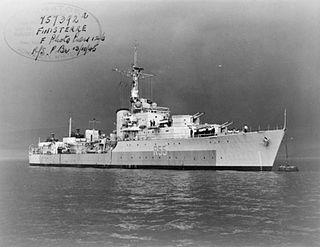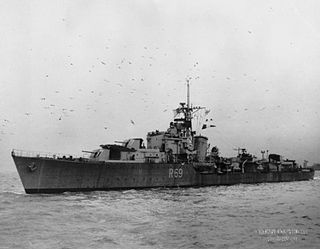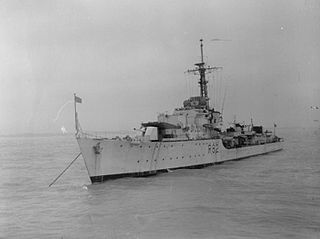
The Battle class were a class of destroyers of the British Royal Navy (RN) and Royal Australian Navy (RAN), named after naval or other battles fought by British or English forces. Built in three groups, the first group were ordered under the 1942 naval estimates. A modified second and third group, together with two ships of an extended design were planned for the 1943 and 1944 estimates. Most of these ships were cancelled when it became apparent that the war was being won and the ships would not be required, although two ships of the third group, ordered for the RAN, were not cancelled and were subsequently completed in Australia.

HMS Finisterre was a Battle-class destroyer of the Royal Navy (RN). She was named after one of the battles of Cape Finisterre. She was the first and thus far the only ship of the Royal Navy to bear this name.

HMS Camperdown was a Battle-class destroyer of the Royal Navy (RN). She was named after the Battle of Camperdown, a naval engagement between the British and Dutch that took place in 1797, and which resulted in a British victory.

HMS Aisne (D22) was a 1943 or later Battle-class fleet destroyer of the Royal Navy. She was named after one of the Battles of the Aisne.

HMS Agincourt (D86) was a later or 1943 Battle-class fleet destroyer of the Royal Navy. She was named in honour of the Battle of Agincourt, fought in 1415 during the Hundred Years' War. Agincourt was built by R. & W. Hawthorn, Leslie & Company Limited on the River Tyne. She was launched on 29 January 1945 and commissioned on 25 June 1947.

HMS Corunna (D97) was a later or 1943 Battle-class fleet destroyer of the Royal Navy. She was named in honour of the Battle of Corunna, which took place during the Peninsular War in 1809 between British and French forces. Corunna was built by Swan Hunter & Wigham Richardson Limited on the Tyne. She was launched on 29 May 1945 and commissioned on 6 June 1947.

The Weapon class was a class of destroyers built for the British Royal Navy towards the end of World War II. They were the smaller counterpart to the Battle class and were the first new destroyer designs for the Royal Navy since the Second World War Emergency Programme. 20 ships were planned, of which only 13 were laid down and 7 were launched, but the cessation of hostilities resulted in only 4 being completed for service. Two of the ships had been previously ordered as part of the planned C class, or 15th Emergency flotilla, of 1944, but the orders were changed to the new design.

HMS Battleaxe was a Weapon-class destroyer of the Royal Navy, completed just after the Second World War.

HMS Swiftsure was one of three Minotaur-class light cruisers built for the Royal Navy during the Second World War. She was laid down by Vickers Armstrong at Newcastle upon Tyne on 22 September 1941, launched on 4 February 1943 by Lady Wake-Walker and commissioned on 22 June 1944. The first of a new Minotaur class, a development of the later Colony class with extra beam and a fifth twin 4 inch turret. Swiftsure was the last Royal Navy cruiser completed during World War II and was the first British cruiser designed around the concept of an operations room and modern radar, with sensor screens and communications positioned for efficient operation. During her service in the Pacific in 1945, she proved the most efficient anti-aircraft cruiser in the fleet and was the first Royal Navy cruiser with the Type 274 lock-and-follow radar targeting system for her main armament.

HMS Broadsword was a Weapon-class destroyer of the British Royal Navy in service from 1948 and scrapped in 1968.

HMS Scorpion was a Weapon-class destroyer of the British Royal Navy in service from 1947 and scrapped in 1971. Originally named Centaur, the ship was renamed Tomahawk and finally Scorpion before her launch.

HMS Rocket was an R-class destroyer of the Royal Navy that saw service during Second World War. Built by Scotts Shipbuilding and Engineering Company in Greenock, Scotland, she was launched in October 1942 and commissioned in August 1943.

HMS Relentless was an R-class destroyer of the Royal Navy that saw service during World War II. She was later converted into a Type 15 fast anti-submarine frigate, with the new pennant number F185.

HMS Ulysses was a U-class destroyer of the British Royal Navy that saw service during World War II. She was later converted into a Type 15 fast anti-submarine frigate, with the new pennant number F17.

HMS Urania was a U-class destroyer of the British Royal Navy that saw service during World War II. After the war she was converted into a Type 15 fast anti-submarine frigate and was scrapped in 1971.

HMS Venus was a V-class destroyer of the Royal Navy that saw service during the Second World War. She was built by Fairfield Shipbuilding and Engineering Company, of Govan, Scotland and launched on 23 February 1943.

HMS Wakeful was a W-class destroyer of the Royal Navy launched in 1943. She saw service during the Second World War and was later converted into a Type 15 fast anti-submarine frigate. She was sold for scrap in 1971.

HMS Crispin was a C-class destroyer of the Royal Navy built by J. Samuel White, Cowes between 1944 and 1946. She was originally to have been named HMS Craccher. She was sold to the Pakistan Navy in 1958 and renamed PNS Jahangir. She was scrapped in 1982.

HMS Creole was a C-class destroyer of the Royal Navy built by J. Samuel White, Cowes between 1944 and 1946. She was sold to the Pakistan Navy in 1958 and renamed PNS Alamgir. She was scrapped in 1982.

HMS Contest was a C-class destroyer of the Royal Navy, built by J. Samuel White, Cowes. Laid down on 1 November 1943 and commissioned on 9 November 1945, she was the Royal Navy's first all-welded warship. She was scrapped in 1960.




















